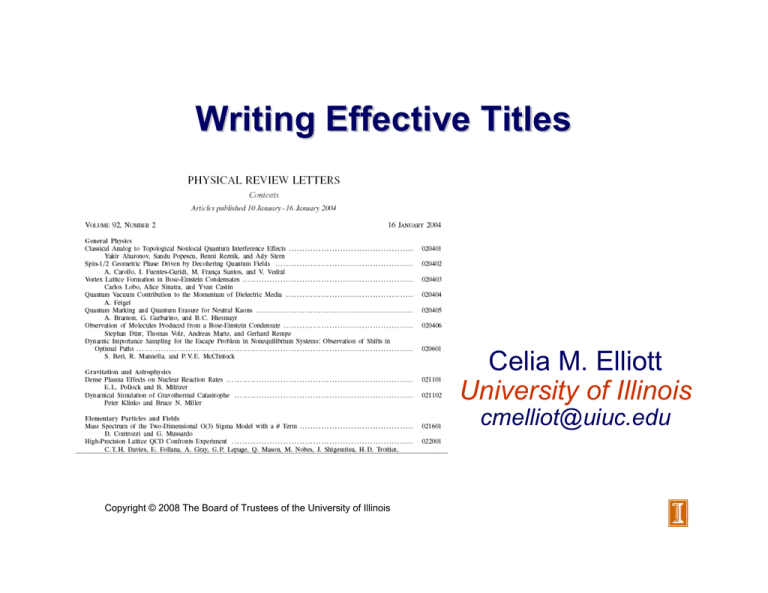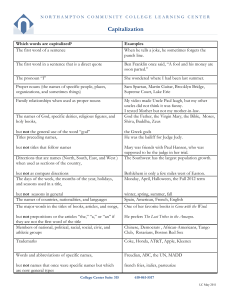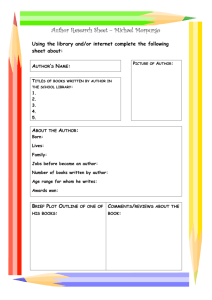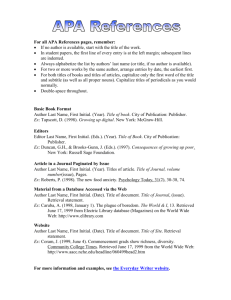Writing Effective Titles Celia M. Elliott University of Illinois
advertisement

Writing Effective Titles Celia M. Elliott University of Illinois cmelliot@uiuc.edu Copyright © 2008 The Board of Trustees of the University of Illinois A good title determines whether somebody invests the time to read your paper or come to your talk Busy physicists employ three criteria The information conveyed in the title The reputation of the author The abstract (ut infra) Play fair; don’t “trick” people into reading your paper by a misleading title Waste of their time Ruins your reputation (ut supra) Daily (real) example: http://xxx.lanl.gov/list/hep-ph/recent 2 Effective titles are concise, descriptive, and interesting Restrict the title to a maximum of 12 words (makes it easier to remember) Put key words first Accurately reflect the content of the paper Avoid unfamiliar acronyms or abbreviations Worst title I have ever seen: “Towards the Observation of Signal over Background in Future Experiments” 3 But not too interesting . . . Would you take seriously a paper with the following title: “Looking from the East at an Elephant Trotting West: Direct CP Violation in B0 Decays” Honestly, I did not make this up; see http://arxiv.org/abs/hep-ph/0203157. 4 Good titles are concise and memorable Original Title Laser-Induced Plasma Phenomena near a Solid Surface at the Incident Intensity in the Range from 10 MW/cm2 to 10 GW/cm2 Better Title Laser Plasma—Solid Surface Interaction at 10 MW cm2 to 10 GW cm2 Investigation of Threshold Characteristics of Materials Fracture Under Impact Loads Produced by Pulsed Magnetic Fields Threshold Fractures Produced by Pulsed Magnetic Fields Second-worst title I have ever seen: “Report of the Subgroup on Alternative Models and New Ideas” 5 To capture the busy reader’s attention, put keywords first Original Title Application of the timedependent local density approximation to conjugated molecules Better Title Time-dependent local density approximation for conjugated molecules A novel approach to New stability estimate for estimate the stability of 1D quantum inverse one-dimensional quantum scattering inverse scattering Advice from AIP: “Words that do not carry information, such as “The…”, “A…”, “On…”, “Investigation of…”, “Study of…”, should be omitted. 6 Excise throw-away introductory fluff Observation of resonance condensation of fermionic atom pairs Capabilities of parallel analyses of the structure of materials by field ion and scanning probe microscopy Study of the ionic Peierls-Hubbard model using density matrix renormalization group methods On the Electron-Electron Interactions in Two Dimensions Theory of traveling filaments in bistable semiconductor structures 7 Perform colon surgery on run-on titles Higgsless Electroweak Symmetry Breaking in Warped Backgrounds: Constraints and Signatures Surface tension in a compressible liquid-drop model: Effects on nuclear density and neutron skin thickness Strong Charge Fluctuations in the Single-Electron Box: A Quantum Monte Carlo Analysis Magnetization plateaus for spin-one bosons in optical lattices: Stern-Gerlach experiments with strongly correlated atoms 8 Do not use words in the title that make qualitative statements about the work being reported “precise”, “accurate” “important”, “influential” “innovative”, “unique”, “groundbreaking”, “brilliant”, “unprecedented” 9 Do not use the names of people, places, or coined words The Phys. Rev. journals also proscribe the name of the accelerator or the type of detector used in paper titles And they disdain “More about…”, “…revisited”, and dangling participles (“…using…”) 10 Avoid all but the most common* acronyms in the title Original Title One-dimensional SPH method Better Title Smoothed-particle hydrodynamics 1D method for gas dynamics applications Application of CVS filtering to mixing in twodimensional homogeneous turbulence Coherent-vortexsimulation filtering applied to mixing in 2D homogeneous turbulence *Refer to the AIP Style Manual 11 Capitalization? Follow the style of the journal to which the paper is submitted Acta Crystallographica Crystallography of a new metastable phase in Zr-N alloy Nuclear Physics B Five-loop ε expansion for O(n) × O(m) spin models Physical Review Letters Complexity of Small Silicon Self-Interstitial Defects Physical Review B Electronic excitations on silver surfaces Science Making Nanoscale Materials with Supercritical Fluids 12




